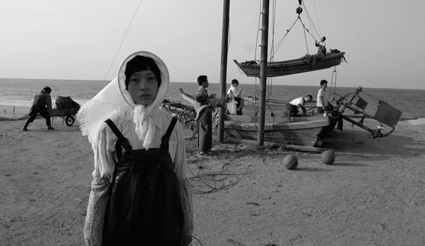the aesthetic of sensation
christen cornell: yang fudong, filmmaker

Seven Intellectuals in Bamboo Forest–Part IV, 2006, Yang Fudong
courtesy the artist, ShanghART Gallery, Shanghai and Marian Goodman Gallery, New York and Paris
Seven Intellectuals in Bamboo Forest–Part IV, 2006, Yang Fudong
STEPPING FROM PADDINGTON’S GOODHOPE STREET INTO YANG FUDONG’S NO SNOW ON THE BROKEN BRIDGE (2006) AT THE SHERMAN CONTEMPORARY ART FOUNDATION, YOU FIND YOURSELF PLUNGED INTO DARKNESS. EIGHT SILVER SCREENS FLICKER TO YOUR RIGHT, ASSISTING YOUR EYES TO ADJUST, WHILE CLUMPS OF BEANBAGS TAKE SHAPE SLOWLY IN THE SHADOWS TO YOUR LEFT. A FINE THREAD OF MUSIC BECOMES DISCERNIBLE—SMATTERINGS OF PIANO AND VIOLIN EMERGING FROM SOMEWHERE BEHIND THE SCREENS. YOU SINK INTO A SEAT AND ALLOW THE ARC OF BLACK AND WHITE IMAGES TO ENGULF YOU.
Your first thought on entering this work is where to place your attention. Each black and white image is gorgeous, yet none lasts more than a few languid seconds and the screens all compete for interest. For a moment your eye rests upon a woman in a silk cheongsam and fur stole, laughing as she crosses a bridge with her friend. Then you’re distracted by a man approaching in long, traditional Chinese robes, or another in a suit and bowler hat. Exquisite shots of plum blossoms and Chinese pavilions, of young lovers and girls in dapper drag, begin and are then replaced, until you relinquish expectations of narrative and give over to a dreamlike state.
Like much of Yang Fudong’s work, No Snow on the Broken Bridge draws on classical Chinese aesthetics, early 20th century fashion and the trope of the young romantic to create a feeling of disconnectedness from the world. Set amidst the scenery of Hangzhou’s famous West Lake, the film has a sense of both floating and ennui, its cast of preened young characters indolent to the point of camp. There are moments when people disappear behind boulders, or lie in the sun with great portent, feeling almost like Picnic at Hanging Rock: young people in their finery experiencing the power of nature and beauty. Running at 11 minutes, with no real beginning or end, the installation is a playful mosaic—an impressionistic dreamscape pregnant with unexplained mystery and meaning.
Downstairs in the gallery’s annexe, Yang’s film Seven Intellectuals in Bamboo Forest (2003-07) continues these themes and visual references—again, in Yang’s signature monochromatic style. An epic work, it consists of five parts, each running between about 30 to 70 minutes and totalling almost five hours in all. The film is loosely based on a story of seven Taoist sages from the Wei Dynasty (220-265BC) who rejected public life in favour of one of seclusion in the forest. Choosing not to belong to the bureaucratic elite, they devoted their lives instead to conversation, poetry and music and the pleasures of food and wine.
As with Broken Bridge, Seven Intellectuals evokes a sensation of drifting, its young and debonair protagonists seemingly lost in their search for meaning. The film also samples imagery from traditional Chinese poetry and painting, mixing this with fashions from 1930s Shanghai to create an urbane and otherworldly feel. Despite this ambience, however, Seven Intellectuals is set in current times, its characters contemporary in their existential dilemmas, their environment a half-demolished, half-built China. Moving from the famous scenery of Huangshan Mountain (the ‘sea of clouds’) to life in a modern apartment, to a farm, to an island and back to the rubble of a modern Chinese city, the film’s five parts present aspects of contemporary life framed by an aesthete’s imagination.
There is something of De Sica’s The Garden of the Finzi-Continis (1970) in Seven Intellectuals. These suave and privileged young people are seductive, but cold, their lassitude faintly disconcerting. The film’s melancholy is reminiscent too of Visconti’s Death in Venice and there are moments in the first part of Seven Intellectuals in particular, when youths languishing on rocks or staring off mountain tops echo the young Tadzio pointing to the sky. Yang is working within a number of cinema traditions and has cited both European and Chinese filmmakers as influences on his work.
It is perhaps the combination of these two cultures and their fascination for one another that makes Yang Fudong’s films so alluring, particularly for a Western audience—the plaid suits and mountain mists, the chinoiserie. It’s easy to linger under the spell of these installations, their strangeness providing just the right amount of intrigue (while their familiarity consoles). Yang has stated his attraction to the traditional aesthetic of yihui, or sensation, and this exhibition works on you in this way. Making few demands, these works lull you to a point where it becomes easier to surrender to their beauty than to try to piece together their meaning.
Yang Fudong, No Snow on the Broken Bridge, Seven Intellectuals in Bamboo Forest; Sherman Contemporary Art Foundation (SCAF), Sydney, March 18-June 4, www.sherman-scaf.org.au/exhibitions
RealTime issue #103 June-July 2011 pg. 46






